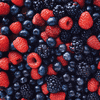
Anthocyanins
Risk free
Alternate Names:
- anthocyan(in)s
- e163a cyanidin
- e163b delphinidin
- e163c malvidin
- e163d pelargonidin
- e163e peonidin
- e163f petunidin
Info from food-info.net:
- Description:
- Function:
- E163a cyanidin : red E163b delphinidin : blue E163c malvidin : purple E164d pelargonidin : orange E164e peonidin : red-brown E165f petunidin : dark red
- Origin:
- Anthocyanins and anthocyanidins are a large group of natural colours. The colour of most fruits, flowers and berries is made up from a combination of anthocyanins and anthocyanidins. Anthocyanins always contain a carbohydrate molecule, whereas anthocyanidins lack this molecule. The individual compounds are isolated from different plant species. E163(i)-(iii) are mixtures. More on anthocyanins and structure, see here.
- Side effects:
- Unknown
Dietary restrictions:- Unknown
Acceptable daily intake:- None determined except for E163(ii) : up to 2.5 mg/kg body weight
Status:- Unknown
Info from proe.info:
- Description:
- Benefits:
- Unknown
- General:
- Unknown
- Harm:
- Unknown
- Legal:
- Unknown
- Use:
- Unknown
- Links:
- Unknown
Dietary restrictions:- Unknown
Acceptable daily intake:- Unknown
Status:- Unknown
ninamvseeno.org -- site no longer live
- Description:
- Unknown
Dietary restrictions:- Unknown
Acceptable daily intake:- is not limited or specified (EFSA, 2013; 2.5 mg/kg for E163ii)
Status:- Approved in the EU.
References: